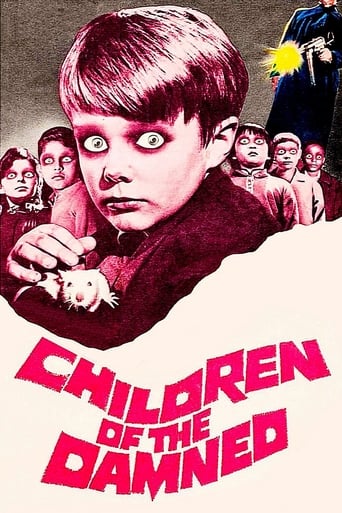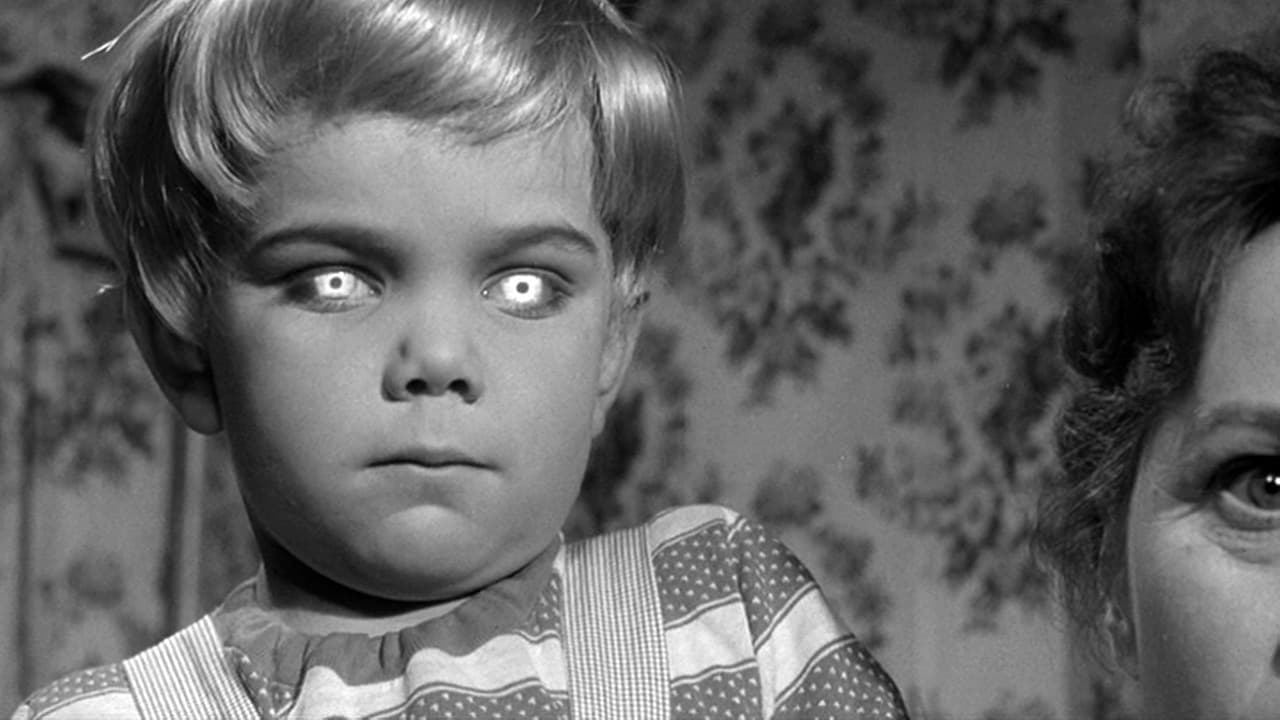Hitchcoc
This turns the intent of the original around and makes the children victims and the humans the bad folks (at least the government and the military). In science fiction, those who have moved way beyond us in evolutionary development are seen as threats, pure and simple. It has been used in stories where we automatically assume and advanced alien arrival means bombs will soon be dropped. Kill them before they kill us. This is understandable, but it gets in the way of our moving our own world along. Here, the blond haired, spooky eyed children (who aren't children in the conventional sense) make an appearance and are destined to meet. They have been conceived in non-traditional ways and have parents who don't have a clue. Eventually, moral people see what is going on, but must butt heads with the larger culture and the "protective" forces. This is nearly as disturbing as the original. However, other than the appearances of the children and how they came to be, this is an independent film and has no connection with its predecessor.
bkoganbing
Another group of children, this time scattered all over the world and not having the tell tale blue eyes and blond hair, have been reported. The British government has had them brought to London, five of them that is, the sixth being British. We're not necessarily blaming aliens this time. Could it be aliens or has man taken a quantum leap in development? That's what Alan Badel and Ian Hendry who are scientists want to know. But Alfred Burke representing the government sees only two alternatives, make use of their telekinetic and mind reading powers or destroy them.Not quite a sequel to Village Of The Damned, Children Of The Damned adds a few new wrinkles to the situation humankind finds itself in dealing with these super kids. Barbara Shelley who is the aunt of the British kid gets taken over and essentially becomes den mother and spokesperson for the children. The might of British defense has definitely met its match.In the end a rather sensible solution is arrived at and not by the grownups.Nice suspenseful science fiction story.
Matthew Kresal
When a film is a success, it is almost inevitable there will be a sequel to it. The classic 1960 sci-fi film Village Of The Damned is no exception to that rule and 1964's Children Of the Damned would be that sequel. While any sequel to Village Of The Damned would have big shoes to feel, this film doesn't quite live to the standards set by the original film. In fact, it is easy to say that Children Of The Damned is very much a sequel in name only that, contradictorily, requires knowledge of the original film for it to make sense as well as being a terribly dated Cold War parable.The film certainly has a respectable cast. Ian Hendry and Alan Badel play Tom Llewellyn and David Neville, who both give believable performances as the two scientists who uncover the children and their powers. Barbara Ferris plays the aunt of one of the children who ends up becoming a spokesperson for the children while under their control. Alfred Burke gives perhaps the film's best performance as British government agent Colin Webster whose involvement only makes the situation worse as the film goes on. Together they are a cast that is more then a match for that in the original film.One of the film's problems though is in its title characters: the children. Due to whatever reason, gone are the seemingly normal yet otherworldly and menacing children of the original. These children are the exact opposite. They are utterly normal children from five places around the world who lack any of the otherworldly feeling or menace of the original children. Even the special effect used on the eyes when the children are using their powers isn't really used and, when it is, it just doesn't look stand up to the effect used in the original film. The result is that perhaps one, single essential element of the film that needed to work just doesn't work.The production values of the film are excellent. In particular the stark black and white cinematography of Davis Boulton gives the film a strong sense of atmosphere and menace throughout which helps the film immensely. The production design of Elliot Scott give the film the same feeling as the cinematography, especially in the form of the destitute church the children come to occupy for much of the film. One element that improves in this film is the score by composer Ron Goodwin that, after a rather mixed result in the original film, is never out of place and put to good use throughout. The success of the production values helps the film out immensely.Along with the children, the script is another essential element that ends up having a rather mixed result. If anything, the script presents this film as a rather confused sequel to say the least. The script seems to require that the viewer have seen the original film to understand all the events taking place. Yet the film seems to spend most of its time wanting to distance itself as far as possible from the original film. The result is a confusing mix: the plot and events make little sense without having seen the original film but the story might as well be anything but a sequel. It also doesn't help that the film, by the admission of screenwriter John Briley, was more or less meant to be more of a Cold War parable. The children can be viewed as scientists around the world who the major Cold War powers (represented by the government officials in the film) want to put to use building ever more powerful weapons of mass destruction. While this would be a good idea to have explored somewhere else, this film doesn't really seem to be either the place to do it or even do it well. If anything the script seems to be drowning in good ideas (such as the revelations that come out in the films last few minutes) that are never put to good use. Also the Cold War parable gives this film something the original doesn't have: a terribly dated feel to it. The result is that the script is a rather mixed affair.Children Of The Damned, even when viewed on its own and not as a sequel, is a rather mixed affair. Despite a fine main cast and excellent production values, the film's supporting cast (the children) and its script both are rather mixed in their results. When viewed as a sequel however, the film comes across as a rather confused sequel that requires knowledge of the original film for it to make sense as well as being a terribly dated Cold War parable to the point of becoming a sequel in name only. All this means that, while a decent film, it never quite works either as a sequel or as an original film either and is a bit of a letdown overall.
ShadeGrenade
'Village Of The Damned' ( 1960 ) ended with the Midwich children blown sky-high by a bomb in a briefcase. Four years later, 'Children Of The Damned' appeared. As John Wyndham had never written a follow-up novel, it was left to John Briley ( later to write 'Gandhi' ) to concoct an original work. Psychologists Colonel Tom Llewelyn ( Ian Hendry ) and Dr.David Neville ( Alan Badel ) are investigating the backgrounds of a group of children from different countries, all of whom possess incredibly high levels of intelligence. The mother ( Sheila Allen ) of one tells them she was a virgin when her son came into the world. When she bawls him out, he forces her to walk into the path of a lorry.The children escape from custody, taking refuge in a derelict church in London. Attempts to force them out meet with little success - the children use their powers on the adults each time. Finally, the army is brought in...Not as good as 'Village' but nevertheless a solid British sci-fi film. Strangely, the first film's events are not mentioned. The Midwich children had blonde hair, these are dark. Their eyes still turn white whenever they use their powers though. The Midwich kids were believed to be aliens - no-one in 'Children' considers this possibility. Instead they are said to be the next stage in human evolution. Not evil as such, they only kill when threatened. Exactly what they are doing on Earth is never revealed. Asked to explain themselves, one says enigmatically: "To be destroyed!". How did they manage to build a solar-powered machine that kills by amplifying the sound of the church organ? A difference of opinion arises between the Hendry and Badel characters. Llewelyn thinks the children should be allowed to live, Neville believes they pose a threat to Mankind and need to be destroyed. Once again Ron Goodwin's music is wonderful ( particularly effective is his use of an electric organ whenever the children use their powers ). The director, Anton M.Leader, later worked on American shows such as 'Get Smart!' and 'Lost In Space'. He does a good job overall, building suspense to a shattering climax as the army accidentally destroy the church ( and killing the kids in the process ). No further films in the series appeared. Some mistakenly regard Joseph Losey's 'These Are The Damned'( 1963 ) as part of it, but apart from the idea of deadly children ( radioactive, not super-intelligent ) they have nothing in common.



 AD
AD








